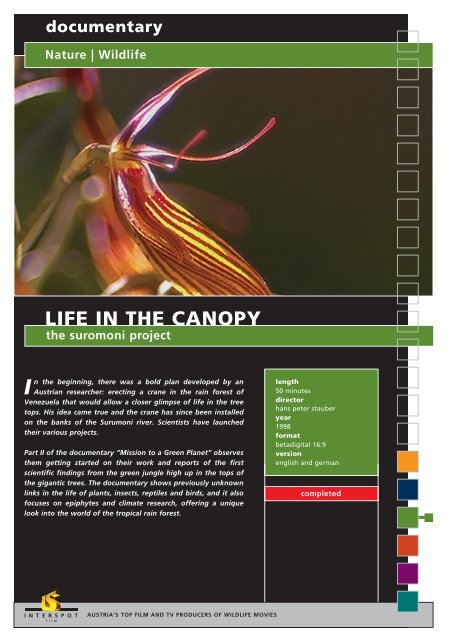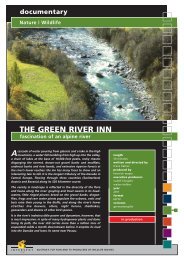documentary Nature | Wildlife LIFE IN THE CANOPY ... - Interspot Film
documentary Nature | Wildlife LIFE IN THE CANOPY ... - Interspot Film
documentary Nature | Wildlife LIFE IN THE CANOPY ... - Interspot Film
You also want an ePaper? Increase the reach of your titles
YUMPU automatically turns print PDFs into web optimized ePapers that Google loves.
I n<br />
<strong>documentary</strong><br />
<strong>Nature</strong> | <strong>Wildlife</strong><br />
<strong>LIFE</strong> <strong>IN</strong> <strong>THE</strong> <strong>CANOPY</strong><br />
the suromoni project<br />
the beginning, there was a bold plan developed by an<br />
Austrian researcher: erecting a crane in the rain forest of<br />
Venezuela that would allow a closer glimpse of life in the tree<br />
tops. His idea came true and the crane has since been installed<br />
on the banks of the Surumoni river. Scientists have launched<br />
their various projects.<br />
Part II of the <strong>documentary</strong> “Mission to a Green Planet” observes<br />
them getting started on their work and reports of the first<br />
scientific findings from the green jungle high up in the tops of<br />
the gigantic trees. The <strong>documentary</strong> shows previously unknown<br />
links in the life of plants, insects, reptiles and birds, and it also<br />
focuses on epiphytes and climate research, offering a unique<br />
look into the world of the tropical rain forest.<br />
AUSTRIA’S TOP FILM AND TV PRODUCERS OF WILD<strong>LIFE</strong> MOVIES<br />
length<br />
50 minutes<br />
director<br />
hans peter stauber<br />
year<br />
1998<br />
format<br />
betadigital 16:9<br />
version<br />
english and german<br />
completed
<strong>documentary</strong><br />
<strong>Nature</strong> | <strong>Wildlife</strong><br />
<strong>LIFE</strong> <strong>IN</strong> <strong>THE</strong> <strong>CANOPY</strong><br />
the suromoni project<br />
Part I of “Mission to a Green Planet” documents the difficulties encountered in assembling<br />
a crane in the middle of the Amazon rain forest. Finally completed in May 1996, the crane<br />
has since been used by scientists in their quest to investigate the tree tops of the tropical rain<br />
forest. A wide range of projects has been launched, already yielding plenty of results and<br />
insights. Part II of the <strong>documentary</strong> focuses on their progress…<br />
High up in the tree tops of the tropical rain forest, thousands of plant species grow<br />
without ever setting foot on the ground: these epiphytes have their first contact with the soil<br />
only when the tree that harbours them is felled. The non-parasitic plants, which use the tree<br />
only as a support, are highly specialised, having learned in the course of evolution to live, survive<br />
and reproduce in the crowns of gigantic trees without contact to the soil. They include<br />
most of the orchids, whose gorgeous blossoms we know and appreciate, as well as many of<br />
our favourite pot plants which we nurse in our living rooms: philodendron, bromelia,<br />
Gesneria, but also lichen, fern, liana and the occasional cactus<br />
Up in the tree tops, epiphytes have created a world of their own. Living up to 50 metres above<br />
ground, they are able to store water in reservoirs, collect humus and cover whole trees with<br />
their dense growth. Forests like those in the Amazon basin actually consist not just of a gigantic<br />
wood rooted in the soil but, additionally, of a second floor, where innumerable plants have<br />
created a garden of equally gigantic proportions which in its sheer diversity and splendour<br />
almost surpasses its ground-based hosts. The fact that an enormous volume of humus and<br />
water is stored in the tree tops has led some experts to talk of the “fractal swamps” or<br />
“fractal gardens” of Amazonia. And they are not exaggerating: a single fairly large bromelia<br />
stores up to 50 litres of water.<br />
Without epiphytes, global water circulation and the global climate might well break down.<br />
But only now, with the crane in place near La Esmeralda on the Orinoco, will the mysterious<br />
world of the epiphytes be opened to the investigative spirit of scientists who are continuously<br />
arriving at entirely new insights.<br />
For further information please contact<br />
HE<strong>IN</strong>RICH MAYER<br />
<strong>Interspot</strong> <strong>Film</strong>-Ges.m.b.H<br />
A-1230 Vienna<br />
Walter-Jurmann-Gasse 4<br />
phone: + 43 1 | 80 120-420<br />
fax: + 43 1 | 80 120-222<br />
e-mail: mayer@interspot.at<br />
www.interspot.at<br />
Coproduced by














